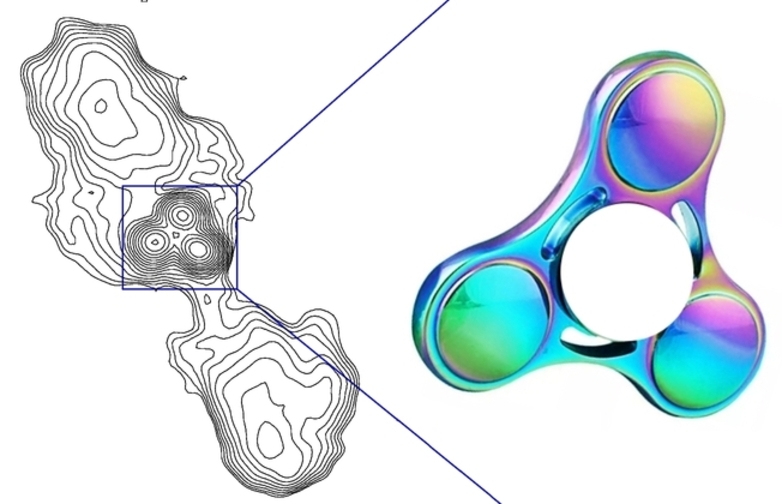Astronomy Object of the Month: 2021, August
< previous Archive next >
J0028+0035 - a fidget spinner like radio galaxy
Fidget spinners are toys that became popular in 2017, typically consisting of four bearings connected with
durable plastic, resembling a triangle with a central bearing serving as a handle.
Radio astronomers use powerful radio telescopes to map the sky in a similar way to observations made with optical
telescopes, such as the Hubble Space Telescope. However, images taken with a radio telescope reveal the sky in a
completely different way. In the radio sky, stars and galaxies are not directly visible, but it shows numerous
complex structures linked to supermassive black holes at the centers of galaxies. Most of the dust and gas surrounding
a supermassive black hole is swallowed by it, but some matter can be ejected with a very high speed into space.
Charged particles that move within a weak magnetic field shine as ghostly structures: radio galaxies, which we can
observe using radio telescopes.


The first picture shows a typical radio galaxy. It consists of a central core, thin jets of relativistic matter terminating with hot spots, and huge lobes. The eponymous radio galaxy J0028+0035 has three components in the centre, thus its morphology resembles a fidget spinner. The central component on the left is a distant blazar, not connected physically with the other objects visible on the map. The other two components on the right, which can be seen better in the right-hand side image, constitute a small radio galaxy consisting of a core and two lobes. J0028+0035 belongs to a rare class of restarting radio galaxies with two pairs of lobes, involving components that emerged from two different cycles of activity of the central object.
Moreover, to make yourself better acquainted with radio galaxies, we invite you to get involved with the "Radio Galaxy Zoo: LOFAR", which is a part of the Zooniverse project, the world's largest and most vibrant community-based research platform based on citizen science community. Participating in the "LOFAR Radio Galaxy Zoo" will become an exciting scientific adventure for you, while helping professional radio astronomers in exploration of the Universe.

Original publication: Marecki, A., Jamrozy, M., Machalski, J., Pajdosz-Śmierciak, U., Multifrequency study of a double-double radio galaxy J0028+0035, 2021, MNRAS, 501, 853.
The research was conducted at the Department of Stellar and Extragalactic Astronomy and the Department of Radioastronomy and Space Physic Jagiellonian University’s Astronomical Observatory (OAUJ). The work was supported by the Polish National Science Centre through the grant 2018/29/B/ST9/01793.
|
Marek Jamrozy Astronomical Observatory Jagiellonian University M.Jamrozy [at] oa.uj.edu.pl |


